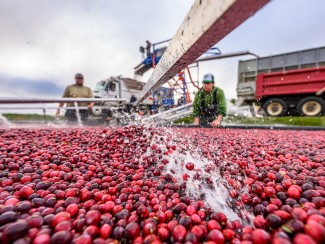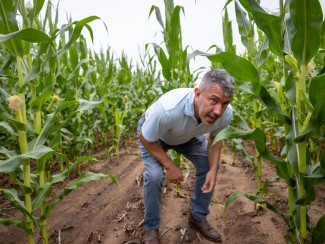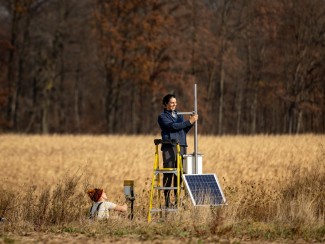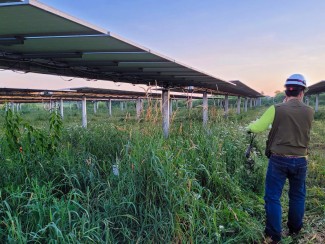For pollinators and pest-eaters in the patchwork habitats of Wisconsin, the answers may lie in land restoration and management.

It’s a common late summer sight in south-central Wisconsin: a prairie in bloom, with tall, waving grasses peppered with bursts of yellow, purple, and white. But turn around, and you might be greeted with another everyday Wisconsin view: a green sea of cornstalks undulating in the breeze or a low field of soy stretching to a distant wooded horizon.
With roughly one-third of its land area devoted to farming, Wisconsin is unquestionably an agricultural state. But most of that farmland exists within a patchwork of other land covers — woodlands, prairies, waterways, and urban spaces.
From a bug’s-eye view, the distinct terrains offer different types and amounts of food, habitat, and other resources. What’s more, those resources vary across time as well as space, as plants sprout, leaf out, bloom, and attract pests at different times during the growing season.
Entomology professor Claudio Gratton studies how the ecology of these mixed agricultural landscapes supports insects that provide the useful services of pollination and pest control, including several species of bees and lady beetles. Previous research in his lab helped inform Wisconsin’s 2015 Pollinator Protection Plan, which identified best practices for supporting pollinating insects on farms, prairies, roadsides, and elsewhere.
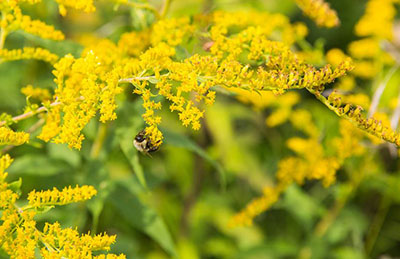 But the state’s agricultural landscapes are constantly shifting. Farm fields may be taken out of crop production as incomes drop or as family lands are passed down to generations no longer interested in working the land. Other land may be used to grow different types of crops, including dedicated bioenergy feedstocks such as switchgrass.
But the state’s agricultural landscapes are constantly shifting. Farm fields may be taken out of crop production as incomes drop or as family lands are passed down to generations no longer interested in working the land. Other land may be used to grow different types of crops, including dedicated bioenergy feedstocks such as switchgrass.
Researchers in Gratton’s group, part of UW–Madison’s Wisconsin Energy Institute, are working to understand how and where beneficial insects fit within the mix of agricultural and natural landscapes in the state. One goal, he says, is to understand how management decisions made on those lands affect insect populations. Another is to take a step back and look at the surrounding areas to begin to learn how the proximity of other types of land cover affects ecological outcomes.
“We might be able to learn something from our natural landscapes to then create managed landscapes that provide those same needs,” Gratton says.
Bumble bees thrive in restored lands
Looking out from a rocky ridge outside Black Earth, Wisconsin, the diversity of the landscape is clearly visible. A narrow finger of remnant prairie meanders along the top of the ridge and slopes down to agricultural land on both sides — a corn field on one flank, a small vegetable plot on the other. Beyond the prairie lies a wooded hillside.
Jade Kochanski, an entomology graduate student in Gratton’s lab, is here to look for bumble bees. The land, a state natural area called Black Earth Rettenmund Prairie, is one of about three dozen properties she has visited during the past two years for a project in partnership with the Natural Resources Conservation Service (NRCS), an agency of the U.S. Department of Agriculture. Most of the sites are privately owned former farmlands that are now enrolled in a NRCS conservation easement program aimed at restoring and protecting natural landscapes. When a landowner no longer wants to farm a piece of land, NRCS might purchase the property and restore wetlands or prairies.
The program has long focused on providing high-quality wildlife habitat, especially for game animals. But another goal, Kochanski says, “is to conserve natural resources to make our farming systems more productive. As we know, pollinators are really important for our food system. And so the NRCS has taken an interest in how these pieces of land can be used to help our pollinators.”
The NRCS approached Gratton and UW– Madison botany professor Ellen Damschen to study easement restoration and management practices and assess how well they support pollinators. Kochanski and one of Damschen’s graduate students, Stephanie McFarlane, visited 32 of the more than 700 Wisconsin properties enrolled in the easement program to compare the effects of different management practices, such as reseeding and controlled burning, on flowering vegetation and bumble bees. They are also comparing the restored lands with high-quality remnant prairies.
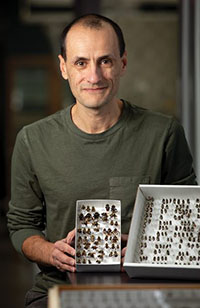
Claudio Gratton displays
shadow boxes containing bee
specimens in his Wisconsin
Energy Institute lab at UW–
Madison.
Black Earth Rettenmund Prairie is one of these remnants; and at this site, as with the others she visited in the past two summers, Kochanski followed the same steps to gather the data she needs. She walked a transect with a mesh net, catching bumble bees and recording their species and sex before releasing them, and she marked out vegetation sampling plots and tallied all the flowers. Good bee habitat should always have something blooming, she notes, so she visited each site three times to track food availability over the course of the growing season.
She is now comparing her measurements of bumble bee abundance and diversity across the sites to better understand how restoration and management practices affect bee communities. Her preliminary analyses suggest that restoration in Wisconsin is good for bumble bees. “We’re seeing increased abundance and diversity at restored sites compared to nonrestored sites,” Kochanski says. What’s more, she adds, bee communities in the restored easements appear similar to those found in the remnant prairies they visited — an encouraging result for the NRCS’s efforts to restore natural ecosystems.
The specific types of management practices used in restoration seem to matter less for bumble bee health than simply whether a site was restored with native seeds. But the composition of the surrounding landscape may make a difference, Kochanski says. She’s still digging into her data, but she expects that having more natural habitat nearby may be more important for bees living in unrestored former fields, where high-quality habitat and food may be harder to come by.
If that holds true, it could help identify potential new easement sites that might be more likely to become successful restorations. “We’re hoping at the end of the study we’ll be able to give NRCS some management recommendations,” she says.
Diverse landscapes keep aphid-eaters well fed
Landscape context is likely to be important for other flying insects as well. Ben Iuliano, a graduate student in agroecology and integrative biology, is studying lady beetles, which are important predators in many Wisconsin ecosystems. They feast on soft insects, such as aphids, mites, and scale insects, many of which are plant pests. In Wisconsin, lady beetles are an important control agent of the soybean aphid, Iuliano says. He and his team of field assistants spent the summer of 2019 visiting fields, forests, and prairies to survey lady beetle numbers and potential food sources in different types of mixed natural and agricultural landscapes.
“We have 17 different landscapes across the southern part of the state that vary in their composition of different land covers. Some have a lot of corn, some have very little agriculture,” he says. “What we’re interested in is how landscapes with different compositions of different types of habitat are differentially supporting ladybug populations over the course of a growing season.”
Past work shows that landscapes with more diverse vegetation host larger predatory insect populations, Iuliano says. He wants to know why.
Much of that difference may have to do with food. The small, soft-bodied insects that comprise most of a lady beetle’s diet prefer tender plant growth that they can pierce with their sucking mouth parts. Often that means new shoots and leaves, which predominate early in the plant’s growing cycle. As plants mature, they may support fewer sap-suckers, which in turn means less food for lady beetles. So a traditional monoculture field such as soybeans might offer a rich source of food — but for only a short time during the growing season.
“Having food that’s continuous in a landscape could be just as important as having lots of food at a particular point in time,” Gratton says. “If there’s nothing around in April and May, maybe that’s not a very good landscape, regardless of what happens in July.”
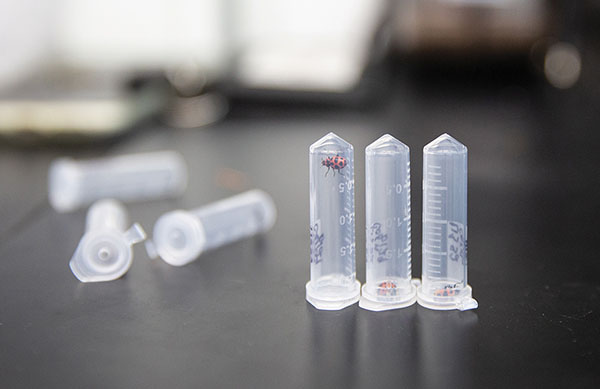
vials in Gratton’s lab at the Wisconsin Energy Institute.
This concept of food continuity is well known for pollinators like Kochanski’s bumble bees, which might need access to multiple flowering species to have pollen and nectar available throughout the growing season. Gratton thinks it is likely just as important for predatory species. With pest-eating critters, though, he notes that the focus tends to be more on getting rid of the prey than on ensuring that the predator has enough to eat.
For these reasons, Iuliano is looking for both predator and prey.
At each of the 17 sites, his team designated 10 sampling locations that span multiple types of terrain. In each location, the researchers installed two posts with sticky yellow cards to attract and trap flying insects. Every few weeks, they replaced the cards and counted the stuck critters to estimate what was using that landscape and the relative populations in that habitat. On each field visit, the crew also sampled more actively with large canvas sweep nets, scanning their catch for both lady beetles and anything small and soft-bodied that the beetles might eat.
They tallied the prey, loaded each lady beetle into a tube, labeled it with the date and location it was caught, and brought it back to the lab for further analysis.
In a previous study, members of Gratton’s group collected lady beetles in landscapes that were dominated by different amounts of corn; then they weighed the insects and measured their body fat composition as an indicator of the abundance of food resources. “We found that lady beetles that were collected in these high-corn landscapes tended to be the leanest ones,” Gratton says. “They hadn’t accumulated the amount of fat reserves that the ones that came from these more diverse landscapes had.”
Iuliano is conducting similar analyses with the lady beetles that were collected in the different landscapes last summer. He’s also taking it a step further to see exactly what the predators ate by studying the contents of their guts with DNA sequencing. Now he’s looking at whether the beetles captured in more diverse landscapes are larger and fatter and whether they have eaten a more diverse diet than the insects captured in corn- and soy-dominated landscapes
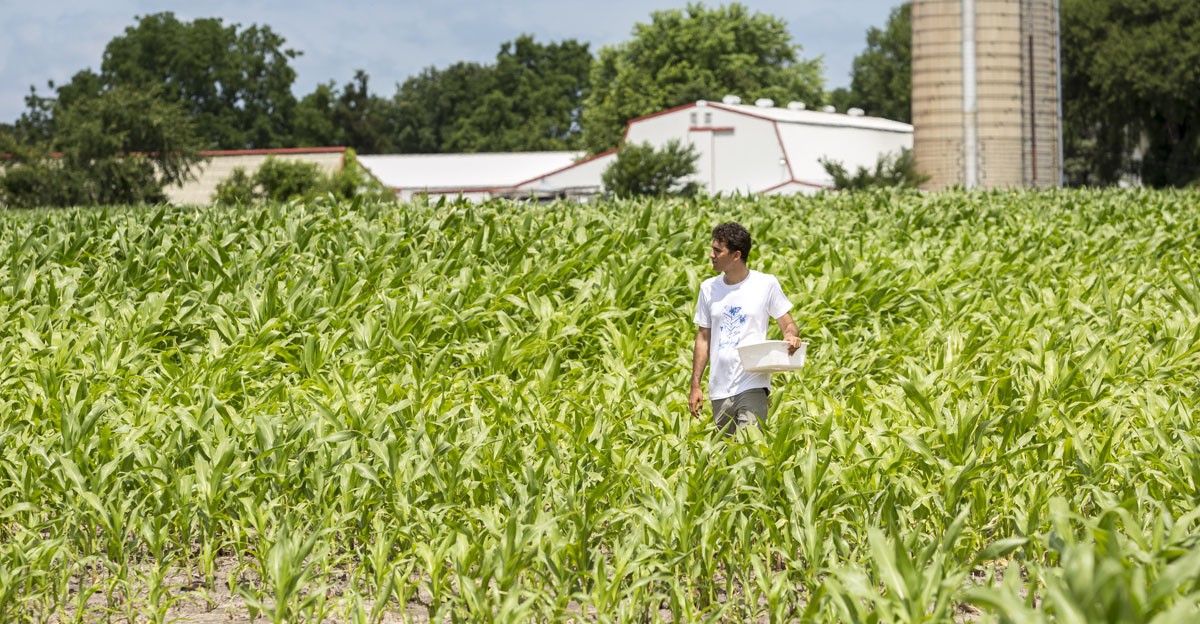
“Landscapes that are more diverse may have more of those early-season resources that may enable populations to persist or grow larger,” Iuliano says. “We’re using the DNA as a way to mechanistically link that landscape diversity with potential benefits for the predators.”
Some of Gratton’s previous work through the Great Lakes Bioenergy Research Center led to a web-based decision support tool called SmartScape, which shows how land-use decisions affect ecosystem outcomes, such as phosphorus runoff, soil quality, and pollinator habitat.
Iuliano hopes his results will similarly help inform land-use and farming decisions. “This is sort of the raw data that goes into a tool like that to help decide what we want our landscapes to look like” to support natural pest control, he says. For a farmer, for example, “maybe you conserve some of those patches of natural area or plant different crops, and maybe you can’t plant as much. But if you’re not paying for as many pesticides, it may be worth it.”

